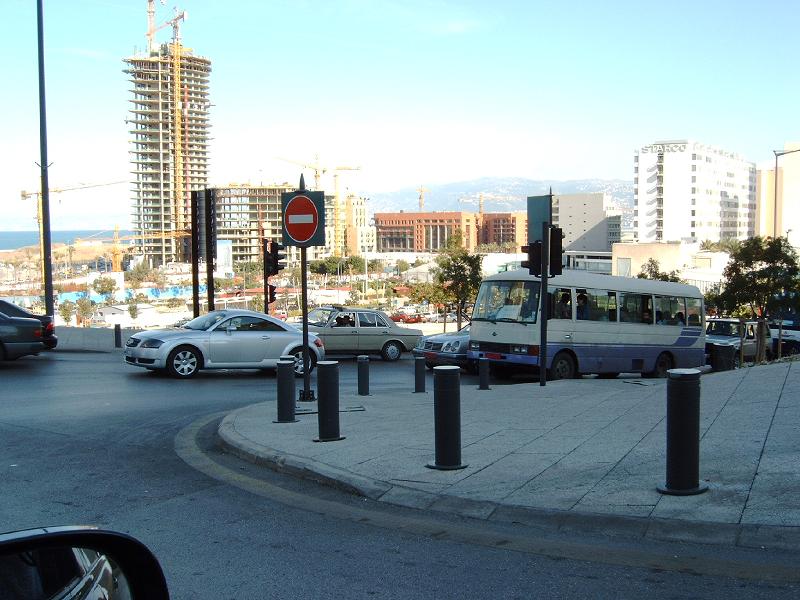 By RAY HANANIA, When you get your first glimpse of Beirut flying over the Mediterranean Sea minutes past the small island of , the Lebanese city glistens like a rainbow of colors.
By RAY HANANIA, When you get your first glimpse of Beirut flying over the Mediterranean Sea minutes past the small island of , the Lebanese city glistens like a rainbow of colors.
The deep blue CyprusMediterranean sea is followed by the brown sand of the coast, the light green palm trees that reach out around the red-roofed buildings, the teal mountain brush and white snow covered mountains.
At one time, Beirut was the sparkling jewel of the Middle East, a robust tourist center that brought mingled tourists seeking oriental adventure with the wealthy whose enthusiasm for enjoyment on the city
Palestinian refugee camps still hug the beaches on the south of the city near the airport.
The camps have transformed over the years from tent cities into ghettos of dilapidated but towering tenement buildings with broken windows, walls, and terraces covered with brown canvas to shade the small and crowded dwellings from the sun.
Beirut faces the afternoon sunset in the west, but it’s future continues to rise.
Although as recently as last week,
Beirut erupted into violent protests over offensive depictions of the Prophet Mohammed by the Danish Newspaper Jyllands-Posten and reprinted in other European media. Demonstrators torched the Danish Embassy and broke the windows of scores of buildings including an ancient church all within a one block radius.
The walls of the building that houses
Denmark’s embassy are scorched black. But Beirut quickly replaced the broken church windows in this city where Maronite Catholic Christians and two sects of Muslims, Sunni and Shiite vie for power.
And just as quickly as the protest and fiery calls for continued protests erupted, they disappeared into the night and
Beirut returned to “normal.”
Beirut has a heavy French influence and many Lebanese, especially the Christians, speak French as fluently as they do Arabic. But it’s real identity is defined by its two major religions.
Beirut is divided into two parts, North Beirut and the northern coast of Lebanon is predominantly Muslim. West Beirut is predominantly Muslim. The two communities mingle but remain separated socially and politically.
The streets of the city still reflect the influence of the French who held a mandate over the Lebanese coastal mountain region for many years until the country became independent and the first real democracy was created that gave all of its citizens a voice in government under a sectarian system that assigns offices by religion.
The office of President is a Maronite Catholic. The Prime Minister is a Sunni Muslim. And the speaker of the Parliament is a Shiite (Shia) Muslim. The system was set up in 1943, the longest surviving Democracy in the
Middle East. Despite the growth of the Muslim population, including the absorption of Palestinian refugees, most forced from their homes in 1948 by Israel, Lebanon is the only Arab country that recognizes Sunday as an important non-working day because of respect to the Christian community.
In most other Arab countries, Friday and Saturday are considered the “weekend,” and Sunday is considered a workday. Muslims observe their religion on Friday afternoon while Jews observe their religious beliefs on Friday night and Saturday.
Lebanon recognizes more than 22 holidays each year observing Christian and Muslim religious dates.
Beirut could easily be mistaken for an Arab neighborhood in Paris.
Entering
Beirut from Hariri Airport, the first icon of globalization that greets you is a large KFC (Kentucky Fried Chicken) red and white bucket with a picture of Col. Sanders on its front. It’s a reminder that anything available in the United States is also available in Lebanon. Maybe more.
But violence also takes modern day forms. Tall banners line the medians of the main highways proclaiming with impunity, “All our disasters are from
America.”
Nearby, though, are billboards promoting other American products, services and franchise stores and restaurants. English is as common as Arabic and French on stores, street signs and posters.
Lebanese police look more like militia soldiers in khaki green camouflage outfits and automatic rifles slung from their shoulders.
The streets are packed with all kinds of cars, from beaters barely able to cough out their black exhaust smoke to the most expensive Mercedes and Lincoln Navigators. Although yellow and white lines mark the lanes on the streets, the drivers race like greyhounds on a
Florida track. It’s amazing how the drivers duck and dive in front of each other without ever bumping and scratching each other.
In massive traffic jams in the early morning and late evening, poor young children tap on car windows begging for money with sullen faces and blackened eyes from years of suffering.
A beautiful golden domed Mosque with four towering minarets are in the center of the downtown and the Muslim call to prayer echoes through the city five times each day beginning early in the morning at sunrise.
Today, a new Christian leader who opposed the Syrian regime for years, Michel Aoun, has returned from Syrian-imposed exile to lead the Free Patriotic Movement in
Lebanon’s parliament. Aoun is struggling to reinforce the country’s commitment to Democracy and fashion a workable and improved Democratic blueprint in Lebanon that can serve as a model for the Middle East.
The Lebanese nightlife is alive and kicking and returning to its heyday, a cornerstone of its economic revival attracting investors and tourists from not just the
Middle East region but from Europe and the Middle East.
 By RAY HANANIA, When you get your first glimpse of
By RAY HANANIA, When you get your first glimpse of  By RAY HANANIA, When you get your first glimpse of
By RAY HANANIA, When you get your first glimpse of